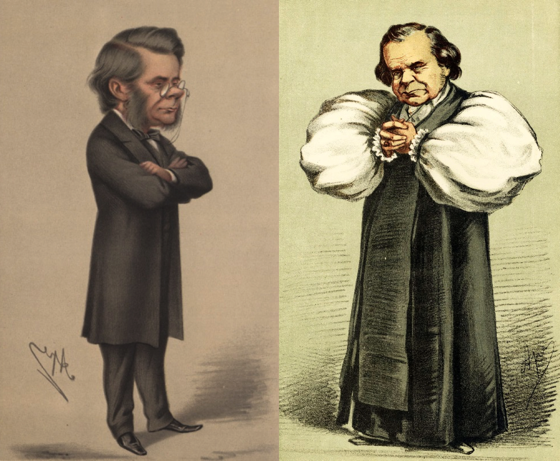 |
| Thomas Henry Huxley and Bishop Samuel Wilberforce, the protagonists |
30th June, 1860, Oxford Museum of Natural History, the scene of one of the biggest punch-ups in Science. It was only built in the few years before and opened that year as a demonstration of how Art could reveal the science of the natural world as the Intelligible embodied expression of the Will of God. The British Association meeting of 1860 was therefore an inaugural event, but not as the authorities might have wished.
Imagine
being asked to compose a piece of music for a friend’s retirement in that
location (if you happen to be a composer of Darwin-related music). A bit like
being asked to put on a sketch or two at La Scala, or maybe a religious service
in the Vatican. It was a bit too early for the main oratorio (see below), but a
string quartet seemed be lower risk, especially if one had ever written one (I hadn’t).
But it was important to rise to the occasion, as Thomas Henry Huxley did. I
wasn’t up against a different world view or a skilled orator such as Bishop Wilberforce,
but the intellectual history of the place seemed to require some effort.
“As the
debate unfolded, Wilberforce taunted Huxley about his possible ape ancestry, to
which Huxley is claimed to have retorted: 'If then the question is put to me
whether I would rather have a miserable ape for a grandfather or a man highly
endowed by nature and possessed of great means of influence and yet employs
these faculties and that influence for the purpose of introducing ridicule into
a grave scientific discussion, I unhesitatingly affirm my preference for the
ape.’ Admiral Fitzroy held up a bible and exhorted all to believe God rather
than man.” The account is legendary, and probably embellished or distilled, but
that’s essentially what contempories made of it.
I wrote last time about the Adventure of Faith in many areas, science, art and religious
faith. We can’t always prove things which we believe to be manifestly true. There
is no full theory of gravity which includes how it actually works (Einstein’s
is the closest we have) but that doesn’t mean that things don’t fall down. But we
can ‘clear the weeds’ and remove obfuscation. Huxley had that faith in the
correctness of Darwin’s theory – as far as it went – and seemed to want to remove
the irrelevant suggestion of social awkwardness of having apes in the family
tree. But he didn’t understand the full thing, and neither did Darwin, hence
the inclusion of the genetic code in Eyenigma Variations.
The first blog in this series featured the splendid student quartet who played the piece in the setting of the 30/06/1860 debate. Maybe one day a choir and orchestra will perform the full oratorio. I’m grateful to a friend with a good, traditional hand for score writing for copying out the first page of the opening chorus ‘Entangled Bank’ for me.
 |
| Opening chorus 'Entangled Bank', hand-copied score, weighed down by ammonites |
Picture Credits: National Portrait Gallery; David F Gahan copyright






.jpg)




.png)